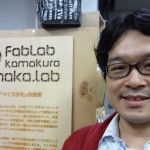OCPC, the CNC for all has arrived
Published 19 January 2016 by Cherise Fong
Entirely open source, with recipe on line, materials accessible in fablabs and soon to be sold as a kit for less than a hundred euros, OCPC or “One CNC Per Child”, conceived in Japan, heralds the revolution of the computer numerical control machine for all.
Tokyo, from our correspondent
At first sight, it’s nothing extraordinary: a hexagonal platform mounted on an acrylic tripod base, three servomotors, an Arduino Uno, a 9V battery, a breadboard, lots of wires. And yet, this bizarre object augurs a new era, that of fab 2.0, where anyone can make their own personal computer numerical control (CNC) machine and adapt it to their needs.
Hiroya Tanaka, the Keio University professor who conceived the project, has already shuffled through a few monikers to describe the beast. First, it was called the “$100 CNC” (the price hasn’t changed for the Delta Kit), subsequently rebranded OCPC for “One CNC Per Child”, an acronym directly inspired by the OLPC (One Laptop Per Child) project. While the name is catchy, its definition is more vague: “personal use fabrication machine”, or more simply, “robot”.

Speaking of which, what is the difference between a CNC machine and a robot? Not much… OCPC is an Arduino-controlled, battery-operated robot mounted on three motorized legs that allow it to move on three axes (x, y, z). For the rest, it’s up to each individual to adapt the machine for their own personal use.
Developed off and on over the course of a year by Tanaka in his lab, in collaboration with his student Gaku Hirota, who engineered the mechanics, OCPC made its premiere on January 14, a total of 25 times, in a classroom on Keio University’s Shonan-Fujisawa Campus. Dozens of first-year students at the Faculty of Environment and Information Studies were tasked with finding an original application for this otherwise generic machine that they had just built. Then each group presented their solution in a short video.
“A Morning with Deltabot”, Genta Mochizawa, one of the resulting films (2016):
Of the 25 groups, around half reinterpreted some aspect of the daily morning routine, cooking or food. These playful applications ranged from a french-fry dispenser at mouth’s height (one at a time, to avoid getting greasy fingers while typing) to an apple peeler rotating the fruit under a screwdriver blade (with the potential of etching or carving out more precise forms, depending on programming accuracy and engineering stability). Another popular application involved replacing the human hand (or mouth) to massage (or kiss)… and why not a guard dog disguised as a plant?
In summary, commented the professor, these first OCPC applications, sometimes practical but always playful, fall into three categories: subtitute for human, extension of human and new invention. Indeed, this last category was represented by the winner of the Tanaka Prize: the weird eye with the wandering pupil, installed in public space.
OCPC eye, winner of the Tanaka Prize (2016):
So if it’s possible to innovate conceptually with six 28.5 cm rods mounted on three servomotors—which are neither very precise, nor very stable—one can only imagine what could result from further development, more time and wider participation…
Tanaka confirms that OCPC is first and foremost an educational tool (which can be built in two hours with a laser cutter) to learn how to make a CNC machine (and thus understand how it works) with all its electronic, programming, mechanical and material parts.
He reflects on the fact that today’s teenagers have only known a world saturated by a plethora of prefabricated digital gadgets. He observes that his own students often use 3D printers, but they don’t really understand the mechanics behind them. OCPC is an entry point into the world of digital fabrication, and heralds the very beginning of the fab 2.0 era. “The first experience is the most important,” affirms the fab professor.

What are the next steps for the OCPC project? Tanaka talks about writing a book dedicated to the machine and developing a modular kit (for $100 or less) to distribute more widely. He also intends to invite more designers to participate in the project, in order to attract a wider, more diverse audience. Five candy colors, nostalgic of the very first iMacs, already serve this purpose.
“In Japan,” he says, “open source hardware is still limited to geeks and engineers. But if we’re talking about education, fablab culture, we need to open our minds to new communities, such as designers, families…”
In the meantime, we can’t wait to go to the fablab to make our own little robot with a thousand and one personal uses, one machine per maker.
Complete OCPC Delta Kit recipe on Fabble (in Japanese only for now, but soon to be translated into English)

